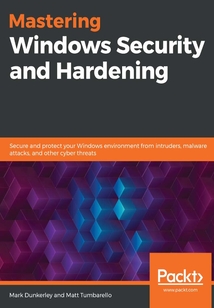舉報 

會員
Mastering Windows Security and Hardening
AreyoulookingforeffectivewaystoprotectWindows-basedsystemsfrombeingcompromisedbyunauthorizedusers?MasteringWindowsSecurityandHardeningisadetailedguidethathelpsyougainexpertisewhenimplementingefficientsecuritymeasuresandcreatingrobustdefensesolutions.WewillbeginwithanintroductiontoWindowssecurityfundamentals,baselining,andtheimportanceofbuildingabaselineforanorganization.Asyouadvance,youwilllearnhowtoeffectivelysecureandhardenyourWindows-basedsystem,protectidentities,andevenmanageaccess.Intheconcludingchapters,thebookwilltakeyouthroughtesting,monitoring,andsecurityoperations.Inadditiontothis,you’llbeequippedwiththetoolsyouneedtoensurecomplianceandcontinuousmonitoringthroughsecurityoperations.Bytheendofthisbook,you’llhavedevelopedafullunderstandingoftheprocessesandtoolsinvolvedinsecuringandhardeningyourWindowsenvironment.
目錄(121章)
倒序
- 封面
- 版權信息
- Why subscribe?
- Contributors About the authors
- About the reviewer
- Packt is searching for authors like you
- Preface
- Section 1: Getting Started
- Chapter 1: Fundamentals of Windows Security
- Understanding the security transformation
- Living in today's digital world
- Today's threats
- Identifying vulnerabilities
- Recognizing breaches
- Current security challenges
- Implementing a Zero Trust approach
- Summary
- Chapter 2: Building a Baseline
- Introduction to baselining
- Policies standards procedures and guidelines
- Incorporating change management
- Implementing a security framework
- Building baseline controls
- Implementing a baseline
- Incorporating best practices
- Summary
- Chapter 3: Server Infrastructure Management
- Technical requirements
- Overview of the data center and the cloud
- Implementing access management in Windows servers
- Understanding Windows Server management tools
- Using Azure services to manage Windows servers
- Summary
- Chapter 4: End User Device Management
- Technical requirements
- Device management evolution
- Device Imaging and Windows Autopilot
- Microsoft Endpoint Configuration Manager
- Intune Mobile Device Management (MDM)
- Introducing Microsoft Endpoint Manager
- Summary
- Section 2: Applying Security and Hardening
- Chapter 5: Hardware and Virtualization
- Technical requirements
- Physical servers and virtualization
- Introduction to hardware certification
- BIOS and UEFI TPM 2.0 and Secure Boot
- Advanced protection with VBS
- Hardware security recommendations and best practices
- Summary
- Chapter 6: Network Fundamentals for Hardening Windows
- Technical requirements
- Network security fundamentals
- Understanding Windows Network Security
- Windows Defender Firewall and Advanced Security
- Introducing Azure network security
- Summary
- Chapter 7: Identity and Access Management
- Technical requirements
- Identity and access management overview
- Implementing account and access management
- Understanding authentication MFA and going passwordless
- Using Conditional Access and Identity Protection
- Summary
- Chapter 8: Administration and Remote Management
- Technical requirements
- Understanding device administration
- Enforcing policies with MDM
- Building security baselines
- Connecting securely to servers remotely
- Introducing PowerShell security
- Summary
- Chapter 9: Keeping Your Windows Client Secure
- Technical requirements
- Securing your Windows clients
- Introducing Windows Update for Business
- Advanced Windows hardening configurations
- Windows 10 privacy
- Summary
- Chapter 10: Keeping Your Windows Server Secure
- Technical requirements
- Windows Server versions
- Installing Windows Server roles and features
- Configuring Windows updates
- Connecting to Microsoft Defender ATP
- Hardening Windows Server
- Deploying Windows Defender Application Control
- Summary
- Section 3: Protecting Detecting and Responding for Windows Environments
- Chapter 11: Security Monitoring and Reporting
- Technical requirements
- Monitoring with MDATP
- Deploying Log Analytics
- Monitoring with Azure Monitor and activity logs
- Configuring ASC
- Creating performance baselines
- Summary
- Chapter 12: Security Operations
- Technical requirements
- Introducing the SOC
- Using the M365 security portal
- Using MCAS
- Configuring Azure ATP
- Investigating threats with Azure Security Center
- Introducing Azure Sentinel
- Microsoft Defender Security Center
- Planning for business continuity and DR
- Summary
- Chapter 13: Testing and Auditing
- Technical requirements
- Validating controls
- Vulnerability scanning
- Planning for penetration testing
- Security awareness and training
- Summary
- Chapter 14: Top 10 Recommendations and the Future
- The 10 most important to-dos
- The future of device security and management
- Security and the future
- Summary
- Other Books You May Enjoy 更新時間:2021-06-18 18:38:28
推薦閱讀
- Extending Symfony2 Web Application Framework
- Mobile Forensics Cookbook
- Metasploit Penetration Testing Cookbook(Second Edition)
- 零信任網絡:在不可信網絡中構建安全系統
- 網絡運維親歷記 (網絡運維紀實文學)
- Spring Security(Third Edition)
- 網絡安全與攻防入門很輕松(實戰超值版)
- 學電腦安全與病毒防范
- 數據安全與流通:技術、架構與實踐
- Kali Linux高級滲透測試(原書第4版)
- 企業數據安全防護指南
- 交換機·路由器·防火墻(第2版)
- Kali Linux無線網絡滲透測試詳解
- CPK通向賽博安全之路:理論與實踐CPK Solution to Cyber Security:Theory and Practice
- 網絡空間安全體系
- Cisco Firepower威脅防御(FTD)設備的高級排錯與配置
- 黑客防線2011合訂本(下半年)
- 深入淺出密碼學
- 網絡安全管理
- 信息安全導論
- 機器學習互聯網業務安全實踐
- 黑客攻防實戰從入門到精通(第2版)
- Hands-On Enterprise Application Development with Python
- 信息系統等級保護安全建設技術方案設計實現與應用
- Kali Linux 2018:Assuring Security by Penetration Testing
- 密碼技術與物聯網安全:mbedtls開發實戰
- 互聯網安全建設從0到1
- 天地一體化信息網絡信息安全保障技術
- 金融網絡安全
- 零信任安全:技術詳解與應用實踐

